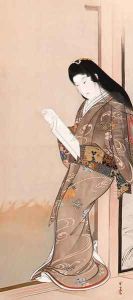Kawenabe Gyosui Paintings
Kawenabe Gyosui was a Japanese artist whose life and career were tragically cut short, leaving a legacy that is both poignant and significant within the context of early 20th-century Japanese art. Born in 1898, Gyosui was part of a period that was marked by vast cultural and social changes in Japan, as the country opened up to Western influences while trying to maintain its own traditions and identity. This era, known as the Meiji period, followed by the Taisho period, was a time of modernization and westernization, and it significantly impacted the arts in Japan, leading to new forms of expression and the blending of Western and Eastern artistic traditions.
Gyosui, whose life spanned the late Meiji and early Taisho periods, was known for his contributions to the development of Nihonga, a style of painting that sought to adapt traditional Japanese techniques and subjects to express the contemporary sensibility of the time. Nihonga artists like Gyosui worked with traditional materials such as silk, paper, and mineral pigments but often explored themes and compositions that reflected the changing world around them.
Despite his short life—Gyosui passed away at the young age of 25 in 1923—his work captured the essence of a pivotal moment in Japanese history. His paintings are characterized by their delicate beauty and often feature themes from nature, a common motif in Nihonga painting, which was seen as a connection to the purity of traditional Japanese aesthetics amidst rapid modernization. Gyosui's ability to infuse his work with a sense of tranquility and subtle elegance has led to a lasting appreciation among connoisseurs of Japanese art.
The details of Gyosui's life are less well-known than those of his contemporaries, partly due to his early death and the limited body of work he left behind. However, what is clear is that his artistic vision and skill contributed to the rich tapestry of early 20th-century Japanese art. His work remains a testament to the enduring appeal of Nihonga painting and offers insight into the nuanced dialogue between tradition and innovation that defined the era in which he lived and worked.
